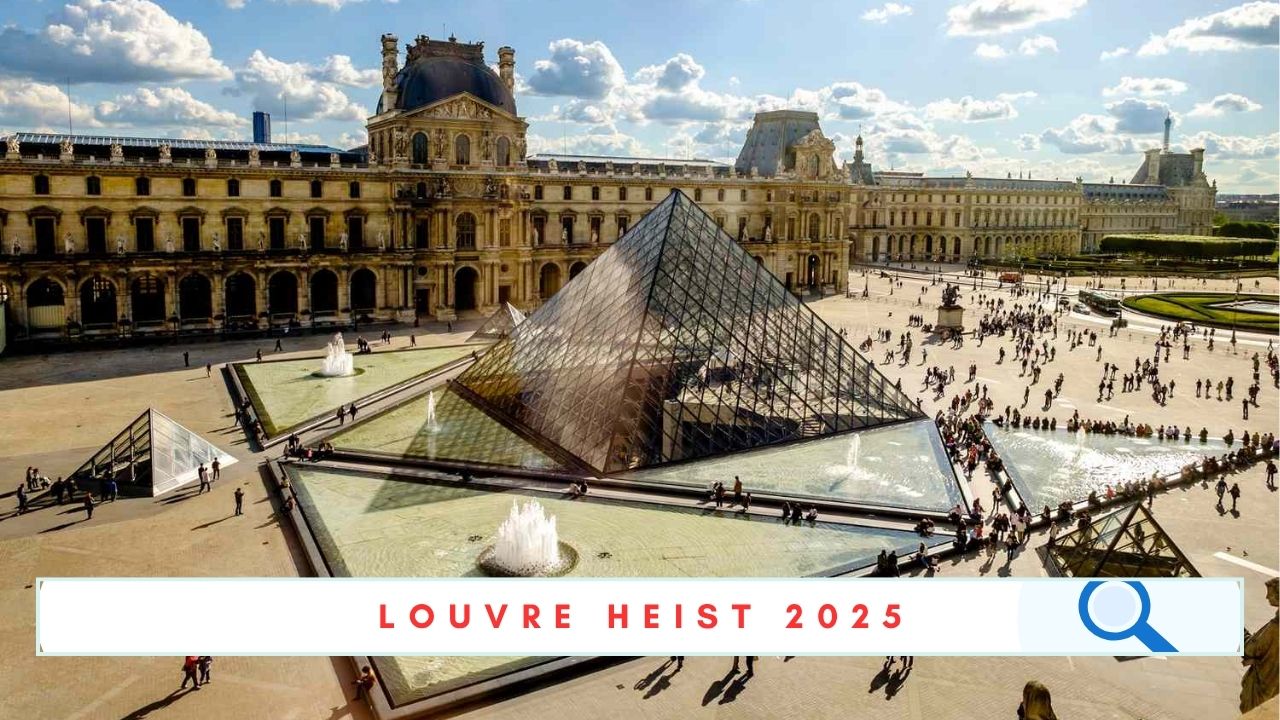Louvre Heist 2025: Everything You Need To Know
On a quiet autumn morning in Paris, beneath the grand glass pyramid of the world’s most famous museum, history was rewritten – not by an artist’s brush, but by the hands of thieves. The Louvre Heist 2025 unfolded in less than eight minutes, yet it shockwaves continue to echo across France and the art world. In broad daylight, while tourists admired masterpieces like the Mona Lisa, a group of masked men disguised as workers breached the museum’s walls and vanished with royal jewels worth more than $100 million – treasures that once adorned queens and empresses of France.
What began as an ordinary Sunday soon turned into one of the most audacious crimes in modern history. The scene – shards of shattered glass, empty velvet displays, and the hollow silence that followed – left museum staff in disbelief. For the Louvre, a place that guards centuries of art and identity, this wasn’t just theft; it was a wound to national pride, a story that blurred the line between legend and reality.
The Louvre Heist 2025 isn’t merely a tale of stolen gems – it’s a haunting reminder that even the world’s greatest fortresses of beauty and history remain vulnerable to human greed. As investigators hunt for answers, the world watches, captivated by a mystery that feels like a movie yet cuts deep into real history.
(Related reading: What Did Eugéne de Montijo Know? The Unspoken Truth of the Iron Mask Girl – another French enigma wrapped in royal intrigue.)

The Morning of the Louvre Heist 2025 – How It All Began
It was a crisp Sunday morning on October 19, 2025, when the unimaginable happened inside the heart of Paris. At around 9:30 a.m., as sunlight steamed through the Louvre’s glass pyramid and early visitors wandered through its vast halls, a small group of men in high-visibility vests arrived near the Galerie d’Apollon – the gilded gallery that houses France’s most precious royal jewels. To onlookers, they looked like maintenance workers. In truth, they were orchestrating one of the fastest and boldest museum robberies in modern history – the Louvre Heist 2025.
Within moments, the thieves had positioned a furniture lift, the kind used for moving heavy objects, against the side of the building. They scaled the wall with precision, smashed through the balcony window, and entered the gallery. Alarms blared, but by the time security could respond, it was already too late. Display cases were shattered, centuries-old jewels gone, and the men had vanished into the streets of Paris – all in under eight minutes.
Visitors stood frozen in disbelief as guards ushered them away from the glittering emptiness that moments ago displayed symbols of France’s monarchy – crowns, tiaras, and diamond-studded relics once worn by queens. The Louvre Heist 2025 has turned an ordinary morning of art and wonder into a scene of chaos and disbelief, rewriting history in the span of a heartbeat.
In the aftermath, Paris awoke not to beauty, but to loss – and questions that still have no answers. How could such a heist take place inside one of the world’s most secure museums, in broad daylight, without a single suspect being caught?
What Was Stolen in the Louvre Heist 2025
When the alarms finally fell silent, the damage inside the Galerie d’Apollon told a story more tragic than words could express. Empty glass cases glimmered under the golden ceilings, and what once dazzled generations of visitors – the royal jewels of France – had vanished. In the chaos that followed, curators and historians wept, not just for their beauty, but for the centuries of heritage that had been stolen in minutes. The Louvre Heist 2025 wasn’t only about jewels – it was about the loss of living history.
The Priceless Royal Jewels of the Louvre Heist 2025
Among the treasures taken were some of the France’s most celebrated artifacts: tiaras, necklaces, and brooches once belonging to Queen Marie-Amalie, Empress Eugénie, and Empress Marie-Louise – women whose elegance defined an era. These weren’t just ornaments; they were silent witnesses to love stories, wars, and revolutions. Experts estimate the total value of the stolen pieces at over US $102 million (€88 million), though their true worth lies beyond numbers.
Each jewel represented a fragment of France’s royal soul – diamonds that once glimmered beneath ballroom chandeliers, emeralds that symbolized royal power, and pearls said to have adorned queens during coronations. To lose them was like tearing a page from France’s living memory.
What the Thieves Left Behind During the Louvre Heist 2025
Not everything glittering in the Galerie d’Apollon was taken that morning. The thieves – in their haste or perhaps by design – left behind one of the museum’s most famous treasures, the legendary Regent Diamond, a 140-carat stone that once crowned Napoleon’s sword. Its survival felt almost symbolic – as if the spirit of France had refused to be fully robbed.
One of the stolen crowns, believed to be that of Empress Eugéne, was dropped and damaged during the escape, recovered hours later by police outside the museum walls. A shattered reminder of what had been lost – and what could never truly be restored.
The Louvre Heist 2025 left the nation in stunned disbelief. France had lost more than its jewels; it had lost a part of its royal heartbet.
How the Louvre Heist 2025 Happened in Just Eight Minutes
The more investigators pieced together the timeline, the more surreal the Louvre Heist 2025 became. It wasn’t chaotic smash-and-grab – it was a masterpiece of planning and precision. Every move was calculated, every second accounted for. The thieves behind the Louvre Heist 2025 knew exactly where to strike, when to enter, and how long they could stay before alarms triggered.
Dressed in reflected construction vests, the gang blended perfectly with the early-morning maintenance crews. Using a furniture lift, they ascended the museum’s outer wall to a balcony leading directly into the Galerie d’Apollon – a section of the Louvre famous for its opulent gold ceilings and priceless royal jewels. Once inside, they smashed glass display cases with surgical precision, knowing which items to take and which to leave behind.
Wat shocked investigators most was the speed and silence of the operation. From the moment they breached the balcony to their escape on waiting scooters, it took less than eight minutes – with barely four minutes spent inside the museum itself. By the time policed arrived, the thieves were long gone, leaving behind nothing but shards of glass and a silent alarm echoing through marble corridors.
Security experts later revealed that parts of the museum’s exterior were not covered by CCTV cameras, giving the thieves a narrow but critical blind spot. This loophole – a gap in an otherwise sophisticated system – turned the world’s most famous museum into an open door for the daring few who had the courage, or arrogance, to exploit it.
At the Louvre Heist 2025, questions arose not only about the thieves’ cunning but also about the museum’s preparedness. How could the guardians of the world’s cultural treasures be outsmarted so easily? The Louvre’s director offered his resignation, admitting the system’s failures, though it was later refused by French authorities – a symbolic gesture that only deepened public frustration.
Eight minutes. That’s all it took for history to be rewritten.
Inside Job or Perfect Crime? The Investigation into the Louvre Heist 2025
In the days that followed the Louvre Heist 2025, Paris felt like a city holding its breath. Every headline, every whisper carried the same question: How could this happen inside one of the most secure museums in the world? What started as disbelief quickly turned into suspicion – that the Louvre Heist 2025 might not have been a flawless crime after all, but an inside job.
French investigators uncovered early clued suggesting the thieves had intimate knowledge of the museum’s security system. They knew which windows were unguarded, which corridors were empty during early hours, and which cameras left blind spots near the Galerie d’Apollon. It was as if they had rehearsed the robbery from within the walls themselves.
Reports from French media revealed that a security guard was placed under investigation for possible collusion. Authorities suspect that someone on the inside might have provided details about the timing of patrols and the alarm system’s weak points. DNA traces and fingerprints found at the scene are still being analyzed, but so far, no arrests have been made.
CCTV footage captured the suspects escaping on motorbikes, racing through narrow Pakistan streets before disappearing into traffic. The precision of the getaway – with multiple vehicles and routes planned – only added to the theory that the operation was orchestrated by professionals with insider coordination.
In response, the Louvre immediately transferred the remaining royal jewels to the Bank of France for safekeeping, ensuring they’d be protected in a vault guarded like the nation’s gold reserves. French authorities launched a nationwide manhunt, with Interpol now aiding in tracking possible movements of the stolen jewels across borders.
Still, weeks after the Louvre Heist 2025, no trace of the thieves has been found. The diamonds may have already been broken apart, their brilliance scattered into anonymity – leaving behind only questions and a deep scar in France’s cultural identity.
Was it the perfect crime … or the ultimate betrayal from within?
The Aftermath of the Louvre Heist 2025 and Its Global Impact
In the aftermath of the Louvre Heist 2025, Paris – a city built on beauty and brilliance – felt dimmer than usual. The Louvre, normally alive with footsteps and whispers of awe, stood in uneasy silence. Outside its gates, tourists gathered not for art, but for answers. The world’s greatest museum had been violated, and the theft wasn’t just a loss of jewels – it was a loss if trust.
News of the Louvre Heist 2025 spread across continents within hours. Major outlets called it “the greatest museum robbery of the century.” France’s cultural minister condemned the act as an “attack on the nation’s soul,” while art historians mourned the symbolic wound inflicted on French identity. These jewels weren’t just sparkling stones; they carried the stories of monarchs, revolutions, and love – fragments of a nation’s heart.
Public outrage was swift and unforgiving. Critics accused the Louvre of complacency, calling for a full security overhaul and demanding accountability from its management. In an emotional statement, the museum’s director called the heist “a tragedy for France”, acknowledging the failure to protect the country’s royal heritage. Though he offered to resign, the French government refused – insisting that restoring national confidence must come before blame.
In a move both practical and symbolic, the remaining crown jewels were transferred to the Bank of France, locked away in vaults meant for the nation’s gold reserves. But to many, the gesture only deepened the sadness It was as if France had hidden away what little sparkle it had left, burying its history for fear of losing it again.
The global art community reacted with alarm. Museums from London to Tokyo began reviewing their own security protocols, realizing that if the Louvre could be breached, no institution was truly safe. Yet beyond the policies and procedures, there lingered a heavier truth – that beauty and greed have always shared the same fragile border.
The Louvre Heist 2025 reminded the world that even the most guarded treasures can vanish in a blink. And sometimes, what’s stolen isn’t just gold or diamonds – but a piece of humanity’s shared story.
Can the Stolen Jewels from the Louvre Heist 2025 Ever Be Recovered?
In the weeks following the Louvre Heist 2025, a single question echoed across across France and beyond: Can the jewels ever be recovered? For historians, it isn’t just about reclaiming glittering stones – it’s about restoring pieces of a nation’s soul. Yet the harsh reality, experts warn, is that time may already be against them.
The Risk of Permanent Loss After the Louvre Heist 2025
Art crimes specialists fear that the stolen treasures may never return in their original form. The thieves behind the Louvre Heist 2025 knew the jewels were far too famous to resell intact – their royal provenance made them instantly recognizable to every collector, dealer, and customs officer in the world. The only way to profit would be to dismantle and destroy them: remove the gems, melt the good, and scatter their brilliance into anonymity.
Such a process, known as “re-cutting for laundering”, has been used in several high-profile art thefts. Once altered, the jewels become untraceable – their beauty preserved, but their history erased. “It’s like watching centuries of French heritage dissolve into dust,” one art historian lamented on French television, her voice trembling with disbelief.
The Global Haunt to Solve the Louvre Heist 2025
Still, hope persists. France’s Brigade de Répression du Banditisme (BRB) – the elite unit that investigates organized crime – continues to lead the international manhunt. Interpol has been alerted, border authorities remain on high alert, and checkpoints across Europe are under surveillance for any sign of the missing gems.
Detectives are also reexamining connections to previous jewel theft rings that targeted high-profile museums and luxury stores in Belgium and Switzerland. The craftmanship, timing, and precision of the Louvre Heist 2025 bear the hallmarks of professionals who have done this before – possibly part of a wider European syndicate.
For now, what remains are fragments of hope and unanswered questions. Somewhere, in a hidden vault or private collection, lie the remnants of France’s royal legacy – silent, unshining, waiting for history to find them again.
What the Louvre Heist 2025 Teaches the World
In the quiet aftermath of the Louvre Heist 2025, as Paris slowly returned to its rhythm, the world was left reflecting on more than just a robbery. It wasn’t simply a loss measured in millions, but a reminder of how fragile beauty and history truly are. Behind every jewel stolen that day centuries of love, power, and identity – pieces of France’s soul, gone in eight short minutes.
The Louvre Heist 2025 stripped away the illusion that some places are untouchable. If even the Louvre – a fortress of art, history, and national pride – can be breached, then no masterpiece is truly safe. It’s a truth both sobering and strangely poetic: that what humanity treasures most is also what it risks losing again and again
Beyond the broken glass and missing crowns, this heist forced the world to comfort something deeper – our relationship with beauty and greed. The same desire that drove kings and queens to collect jewels now fuels those who would steal them. Centuries apart, the motive remains the same: possession. And yet, as history has shown, no one truly owns beauty – they only borrow it for a time.
For France, the Louvre Heist 2025 will forever be more than a crime; it’s a scar in gold leaf – a reminder that even in loss, there’s a story that refuses to fade. The museum may rebuild its defenses, but the real restoration lies in remembering what those jewels once meant: not wealthy, but legacy.
And perhaps that’s what makes this heist so haunting.
Because while the jewels may never return, the story of the Louvre Heist 2025 – its mystery, its tragedy, and its warning – will glitter in history forever.




